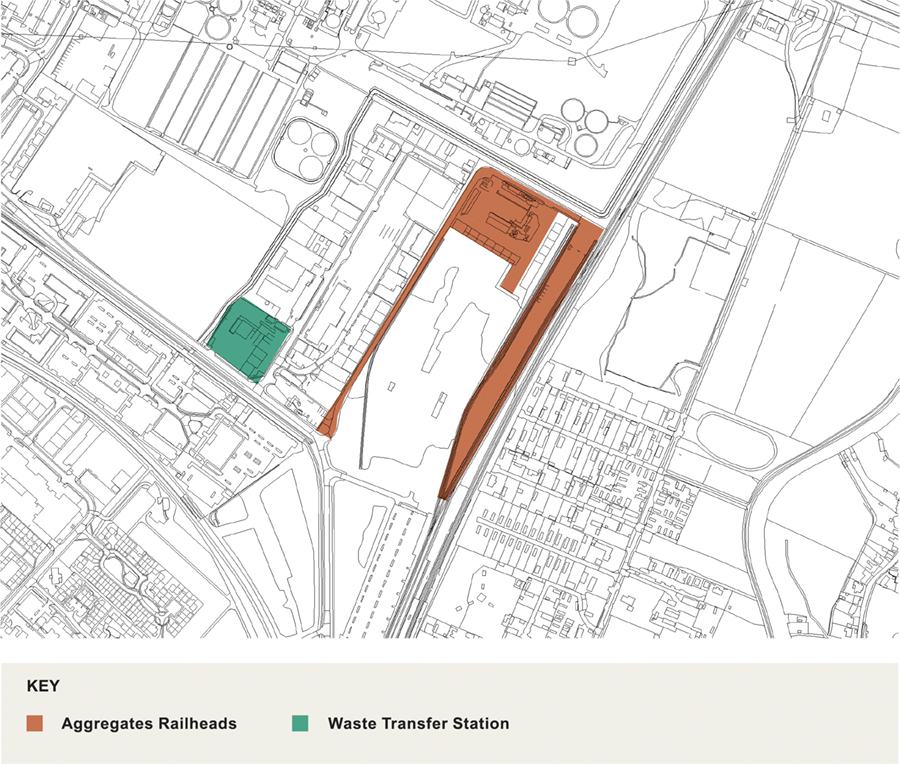Draft North East Cambridge Area Action Plan
8.4 Aggregates and waste sites

Figure 42: Map showing location of aggregates and waste sites within the Area Action Plan boundary
The Area Action Plan area includes safeguarded aggregates railheads and a waste transfer station. The aggregates railheads are of strategic importance and also provide the potential to minimise the movement of construction materials and waste by road. The preferred approach is to retain the aggregates railheads and to relocate the waste transfer station off-site. This policy sets out how this should be achieved and the implications for development on and around these sites.
- You commented that the aggregates railheads and waste transfer station should continue to be safeguarded, and some said that the aggregates railhead should be retained for future needs.
- One comment noted that the aggregates railheads is necessary to meet the wider needs of Greater Cambridge.
- You made comments on the impact of the Waste Recycling Transfer Station on future development, and that further analysis should be undertaken to identify the potential risks and the acceptability of different types of development relating to it. It was acknowledged that the location of an off-site re-provided Waste Recycling Transfer Station has yet to be identified and that land contamination needs to be considered as part of any relocation.
How your comments and options have been taken into account
- In line with your comments, the proposed policy retains the Cambridge North East Aggregates Railheads in its current location. In order to minimise the impact of HGVs on the District Centre, it is proposed to re-align the road access to the site as defined in Policy 21. Nevertheless, if the site can be relocated off-site or it is considered by the local Minerals and Waste Authority that the site is no longer required, then the policy sets out a preferred alternative use for the site.
- The policy, in combination with the Spatial Framework and other supporting policies and diagrams, identifies that the Waste Recycling Transfer Station is an incompatible use within its current location and that it should be relocated off-site through engagement and collaboration with the local Minerals and Waste Authority.
(5) Policy 26: Aggregates and waste sites
The continued operation of the Aggregates Railheads at North East Cambridge is supported due to its contribution to Greater Cambridge's strategic economy. The only acceptable uses adjacent to the existing aggregates railheads will be light industrial (B2) and logistics and distribution (B8) as shown in the land use plan (Figure 11). Proposals for residential uses should not be adjacent to the aggregates railheads as it is unlikely that satisfactory design mitigation can be achieved to protect residential amenity alongside the operational requirements of the aggregates railheads. Any residential proposal in Cowley Road Industrial Estate and Chesterton Sidings, as identified in the Spatial Framework, will need to demonstrate how it achieves acceptable environmental standards (i.e. buffering) from the negative impacts of the aggregates railheads (see Policy 25).
Residential and commercial development of the aggregates railheads site will only be acceptable if the current operation is relocated off-site, subject to meeting the requirements of the Minerals and Waste Local Plan (or future equivalent), or if the Minaerals and Waste Local Plan (or future equivalent) removes the safeguarding policy related to this site.
The safeguarded Veolia Waste Recycling Transfer Station should be relocated off-site. This would need to be undertaken in collaboration with the Local Minerals and Waste Authority and is a pre-requisite to future sensitive development coming forward on surrounding plots.
Relevant Objectives: 3
The Cambridge North East Aggregates Railheads at North East Cambridge is of strategic importance to Greater Cambridge's economy providing an important source of building materials for the wider area. The adopted Cambridgeshire and Peterborough Minerals and Waste Core Strategy (2011) and Site Specific Proposals Plan (2012) designates a safeguarded area for the aggregates railheads at Chesterton Sidings. It is proposed that this site is continued to be safeguarded in the emerging Minerals and Waste Local Plan (2020). A large number of businesses use the facility for importing aggregates via the railway, to then be used in construction and road maintenance across the wider Cambridgeshire area. Given the aggregates facility connection to the railhead, there is potential to minimise the movement of construction materials and waste by road.
In order to protect future residential amenity and other sensitive uses, the Area Action Plan provides for the provision of General Industrial (B2) and Storage and Distribution (B8) uses around the existing operation, providing a buffer.
There has been a long-term ambition to relocate the Aggregates Railheads from North East Cambridge. Whilst this policy and the Area Action Plan Spatial Framework do not seek to relocate this use off-site, they set a clear preference for residential and employment floorspace to be delivered on the site should the site become available for development during the plan period.
The Veolia Waste Recycling Transfer Station is located within the Cowley Road Industrial Estate. This site is also safeguarded by the existing and proposed Minerals and Waste plans. However, the site lies at a key intersection on the Area Action Plan Spatial Framework.
Due to its location and environmental pollutants as well as hours of operation, its continued use is incompatible with the Vision of the Area Action Plan and the Area Action Plan Spatial Framework. Therefore, the Councils will work with the Minerals and Waste Authority and relevant landowners in securing a suitable off-site relocation for this operation.
The Cambridge Waste Water Treatment Plant is also a safeguarded use within the Minerals and Waste Plan. The adoption of the Area Action Plan is predicated on it being possible, through a separate planning process, to relocate this facility to another site, freeing up the land for redevelopment.
- Off-site relocation of Veolia Waste Transfer Station
